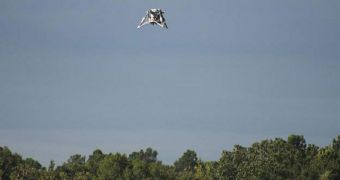Yesterday, August 28, the American space agency's latest robotic lander prototype successfully completed another untethered test flight, this time soaring into the sky to a maximum altitude of 30 meters (100 feet).
Dubbed the Mighty Eagle, the new lander technology could be used in upcoming lunar or Martian missions, although a clear schedule for how this would be implemented has not yet been devised.
After completing a series of tethered flights at the US Army' Redstone Arsenal, near Huntsville, Alabama, the spacecraft was delivered to the NASA Marshall Space Flight Center (MSFC), also in Huntsville, a couple of months ago.
Tests will continue at the NASA installation all the way through September. Early results are very promising, since yesterday's was the second free-flight test that was carried out successfully.
During the flight, mission controllers did not issue any commands to the Mighty Eagle. Rather, they programmed the flight path into its computers, and allowed the test vehicle to fly autonomously, SpaceRef reports.
After takeoff, the lander had to use its sensors to detect the moment it reached its designated altitude. It then followed a programmed flight profile, identified a ground target located about 30 meters (100 feet) away, snapped images of the object, and then proceeded to land smoothly on the ground.
The entire maneuver lasted for 35 seconds, MSFC expert say. Engineers are satisfied with the performances they saw from Mighty Eagle's computers and rocket engines, and say that these results offer great prospects for the future.
“We met our goal for this flight, which was to test the new software at triple the height of our last flight. The higher we go, the more realistic the scenario is compared to an actual descent,” says MSFC Might Eagle test leader, Dr. Greg Chavers.
“We are getting good experience in handling flight hardware and reacting to real-time conditions and anomalies. Each time we test, we load propellant, launch the vehicle, fly the vehicle and land the vehicle. It's hands-on flight experience for young engineers,” concludes flight test conductor Jake Parton.

 14 DAY TRIAL //
14 DAY TRIAL //